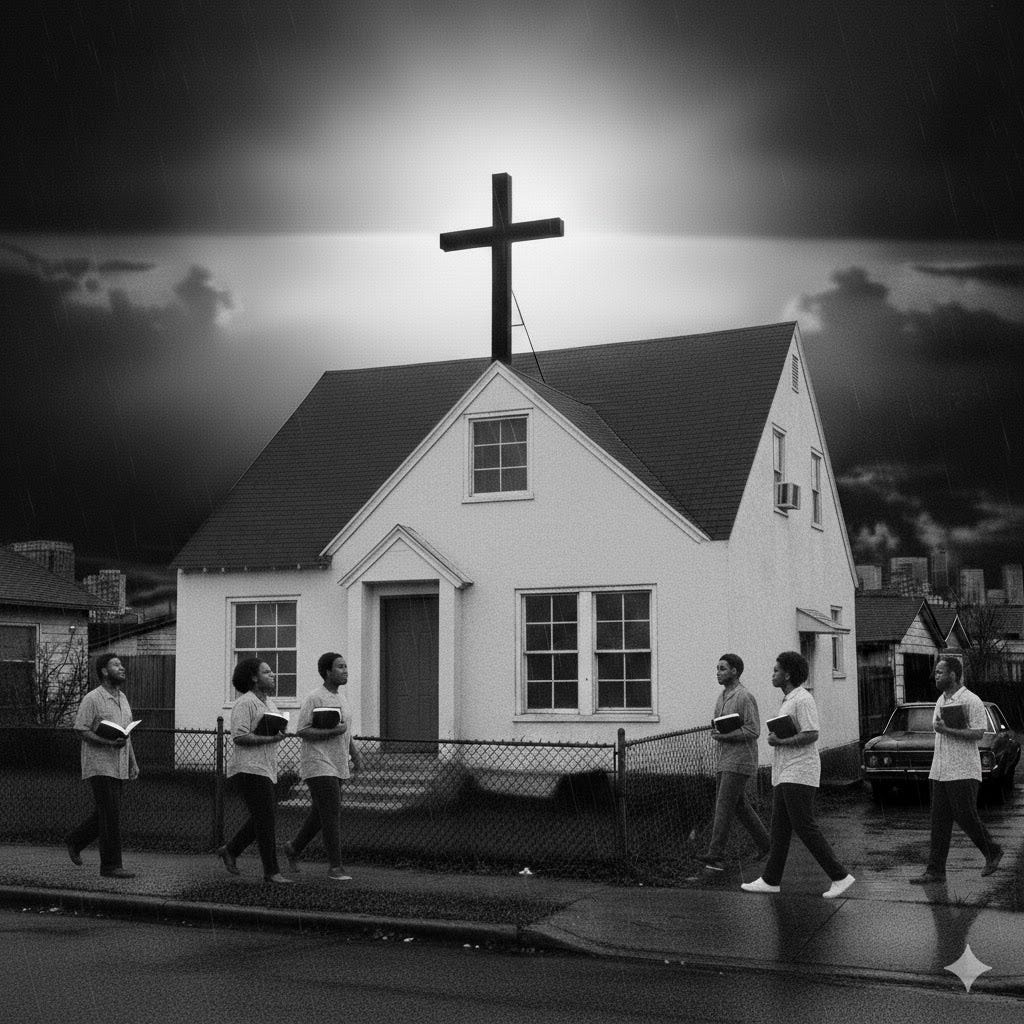One 2500-Member Mega-Church or One Hundred 25-Member Simple-Churches? What’s the Difference?
Mega-Church or Simple-Church: Reclaiming the Apostolic Model in the Book of Acts
If this content is helpful to you or you want to support my work, become a member of my Premium Disciple-Making Cohort 🔗 HERE 🔗. You will have access to my Simple Bible Notes Web App for clean and organized Bible note-taking, quote storage, and teaching notes. Also included is the 24/7 Virtual Disciple-Making Coach for REAL-TIME, REAL-LIFE Disciple-Making ideas and guidance!
Here’s a brutal fact that should shake us awake: By conservative standards, the average megachurch in America spends $3.5 million annually to maintain 2,500 members1. That’s $1400 per person per year to keep the machine running. Meanwhile, 100 simple churches of 25 people each can function on less than $100,000 combined—that’s $40 per person annually.
But this isn’t about money.
🎯 It’s about multiplication versus addition.
It’s about reclaiming the explosive growth pattern of the early church that turned the Roman Empire upside down in three centuries without a single building campaign.
Paul and Barnabas didn’t plant one massive church in Antioch and livestream to the surrounding regions. They planted churches in every city they entered, appointed elders, and moved on 🚶🏽➡️🚶♂️➡️.
🤯 Every. Single. Time. 🤯
Look at Acts 14:23: “Paul and Barnabas appointed elders for them in each church and, with prayer and fasting, committed them to the Lord.”
Difference #1 ➠The Relational Reality Check
In a 2,500-member church, the average attendee knows 50-150 people by name. Most can have a close, engaged relationship with about 5-15 people, which is less than 1% of their church family. The pastoral staff might know 300 members personally on their best day. That leaves 2,200 people essentially unknown by their shepherds.
Robin Dunbar, responsible for the Dunbar Number2, defines the human limits of meaningful relationships based on depth as follows.
1-2: Intimate relationships
5: Close friends
15: Good friends
50: Friends
150: Meaningful relationships
500: Acquaintances
1500: People you can recognize
Compare that to a 25-member simple church. Every single person knows every other person’s story. They know who’s struggling with their teenager, who just lost their job, whose marriage is on the rocks.
When someone doesn’t show up, 24 people notice.
When someone celebrates, 24 people rejoice.
When someone falls, 24 people are there to restore them.
Jesus modeled this.
It’s hard to believe, but most researchers suggest that you will know more people in closer proximity in a small church than you will in a mega-church! It’s built into the culture. It’s influenced by the busyness. It’s dictated by relational dynamics.
👉 He chose twelve. He could have chosen 120 or 1,200. 👈🏻
Transformation happens in the context of life-on-life relationships, not in auditoriums where you can hide in the back row for decades.
Difference #2➠The Programmatic Prison
According to the Hartford Institute for Religion Research3, the average megachurch runs 12 different CATEGORIES of programs. They need programs for children, youth, young adults, singles, marrieds, divorced, seniors, men, women, addicts, grieving, missions, recovery, and everyone in between. Sometimes, each of these categories includes different ministries. Many of these ministries require coordination, volunteers, curriculum, space, and administrative overhead.
The complexity becomes its own beast, demanding constant feeding.
A 25-member simple church needs exactly zero programs. They practice the nine behaviors of a healthy church: Fellowshiping, Passionately Praying, Worshiping, Communioning, Baptizing, Scripturing, Gospeling, Giving, and appointing leaders.
‼️ That’s it. ‼️
They use simple, reproducible tools like the 21-Day Challenge, where everyone discovers truth together, or the 3/3rds format that ensures everyone participates.
The apostolic church in Acts 2:42-47 didn’t have a children’s ministry coordinator or a worship production team. They devoted themselves to the apostles’ teaching, fellowship, breaking of bread, and prayer.
And the Lord added to their number daily.
Difference #3➠The Governmental Challenge
A 2,500-member church typically has a governance structure that rivals a small corporation: senior pastor, executive team, elder board, deacon board, ministry directors, committee chairs. Decision-making can take months. Policy manuals run hundreds of pages. Risk management becomes paramount because one lawsuit could destroy everything.
Meanwhile, 100 simple churches operate 📡 “under the radar” with minimal structure. Each has appointed leaders who know their flock personally. Decisions happen in real-time through prayer and consensus.
❤️🔥 When persecution comes—and it will—they can scatter and multiply rather than watching one massive target get shut down. ❤️🔥
The early church in Jerusalem learned this lesson the hard way. When persecution hit in Acts 8, they were forced to scatter. But notice what happened:
“Those who had been scattered preached the word wherever they went” -Acts 8:4
🔥 Persecution became multiplication because they had learned to be the church, not just attend one.
Difference #4➠The Leadership Difference
ChurchSalary.com research states that the average church has one full-time staff member for every 73-77 church members4. If we average that to 75, then a 2,500-member church would employ about 33 full-time staff.
Typically, even with those numbers, mega-church staff are overwhelmed and burning out at alarming rates. The latest Barna research shows 42% of pastors have seriously considered quitting in the last year 5.
But 100 simple churches with lay leaders? That’s at least 200 equipped leaders (assuming 2 per church), each shepherding 12-13 people.
💪That’s sustainable.
✖︎ That’s reproducible.
📖 That’s biblical.
Paul didn’t wait for seminary graduates. He appointed elders from within the congregation after they’d been disciples for months, not decades.
Our X-groups and discipling communities are producing these kinds of leaders right now. Not professionals who’ve been extracted from the marketplace, but tent-makers like Paul who lead while maintaining their witness in the workspace.
Difference #5➠The Multiplication Mathematics
Here’s where it gets explosive. A megachurch that adds 100 new members per year (4% growth—above average) will have 3,500 members in 10 years.
⛪️ One church.
🔥 But if each of those 100 simple churches plants just one new church every two years—a modest goal—you’ll have 3,200 churches reaching 80,000 people in 10 years.
Which scenario extends the Kingdom further ⁉️
This isn’t theoretical. We’re watching it happen through the Disciple-Making Collective pathway: Seeker Group → X-Group → Discipling Community → House Church → Simple Church.
✔️ Each stage is reproducible. Each tool is simple.
✔️ Each leader can train the next generation.
The Call Back to Our Apostolic DNA
The American church has been seduced by " bigger-is-better” and “less time with more people produces greater results " philosophies. This thinking would have been foreign to Paul, Peter, and James. We’ve traded multiplication for addition, discipleship for attendance, and transformation for status quo.
But there’s a remnant rising who remember that Jesus said, “Where two or three gather in my name, there am I with them” (Matthew 18:20). Not two or three thousand. Two or three.
The tools exist.
The 21-Day Challenge launches people into spiritual disciplines. Prayer mapping identifies your oikos. The 15-second testimony opens gospel doors. X-groups forge accountability. The SOAPS Bible Method ensures everyone can study their Bible.
These aren’t complex programs requiring professional management. They’re simple, biblical, reproducible patterns that any believer can implement.
The Bottom Line
We don’t need another megachurch in urban areas or anywhere else!
We need 10,000 simple churches meeting in homes, apartments, break rooms, and coffee shops.
We need an army of marketplace ministers who don’t quit their jobs but see them as mission fields.
We need mothers and fathers opening their homes and their lives to make disciples who make disciples.
The question isn’t whether God can use megachurches.
He can and does.
The question is whether we’re willing to return to the apostolic model that requires
⛪️ no building funds
🚫 fears no government restrictions
🔥 spreads like wildfire through relationships
Paul’s vision was a church accessible to every man, woman, and child. Not one massive church they all commute to, but thousands of simple churches within walking distance of every lost soul.
What if we actually did it?
What if we planted 100 churches instead of building one?
The math is clear.
The model is biblical.
The mission is urgent.
If you want to learn more about SIMPLE CHURCH and find tools and coaching, DM me or go to disciplemakingcollective.com!
Per Person Giving Research: https://www.churchsalary.com/content/articles/average-per-person-giving-in-church.html
Learn about the Dunbar Number: https://en.wikipedia.org/wiki/Dunbar%27s_number
Find it at Barna: https://www.barna.com/research/pastors-quitting-ministry/




Could you speak more to the topic of appointing leaders who have been discipled for a few months? What does that look like for you? Many small churches (including ours) need more leadership and I wonder sometimes if we wait too long to appoint people as official leaders. What are you doing to build up those potential leaders and then appoint them?
those numbers are shocking